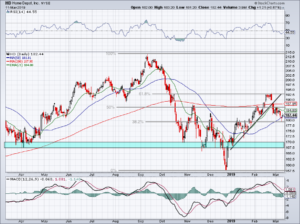After reporting a less-than-stellar quarter on Feb. 26, investors began selling shares of Home Depot (NYSE:HD). It hasn’t been catastrophic for Home Depot stock, but shares have been under pressure since the report.

 Source: Shutterstock
Source: Shutterstock
The numbers of Lowe’s (NYSE:LOW) are likely having an effect too. After initially rallying on the report, the stock fell for seven straight sessions. That’s caused a lot of investors to ask whether these stocks are worth owning at this point.
Spring SeasonInvestors are seemingly overlooking the spring season. When the holidays roll around, of course Home Depot, Lowe’s and others do well in sales. Every family’s handyman or DIY member is eligible for a home improvement gift, right? Right.
But that hardly compares to the numbers that HD stock will put up in the second quarter as homeowners and contractors get to work fixing up houses, cleaning up yards and renovating kitchens and bathrooms. As such, Home Depot will bring on 80,000 new workers to account for the increase in demand.
The downside to all this? These results show up in Q2, not Q1, which HD is in right now. That said, the silver lining here is that investors have an opportunity to buy or accumulate Home Depot stock while it’s under pressure. That’s better than buying a stock red-hot into its best numbers.
Valuing Home Depot StockHome Depot is a high-quality company, but it’s seen better years when it comes to growth. For the current year, estimates call for earnings growth of just 2.2%, despite expectations for 3.2% revenue growth.
Estimates for next year improve, where analysts expect 9.3% earnings growth on 4.6% sales growth. Although, it’s hard to put too much weight into next fiscal year when we’ve only just begun this one.
So where does that leave HD stock? Shares trade at about 18 times this year’s earnings, which isn’t necessarily cheap but is also far from expensive. Investors also need to consider the Home Depot’s 3% dividend yield down near these levels.
Over the last six years, Home Depot has traded with a trailing price-to-earnings (P/E) ratio of 20 on the low end and 25 on the high end. So below this mark now, it’s technically undervalued vs. its recent five-year history.
Further, assuming one overlooks the December selloff, they’d have to go all the way back to 2011 to find HD stock paying out a higher dividend yield. That’s following the company’s 32% boost last month.
Home Depot is making the investments necessary to makes its online game stand tall against companies like Amazon (NASDAQ:AMZN), has a below-average valuation vs. its historical range and is paying out a 3% dividend yield. I’ll admit that the growth is somewhat stagnant for the year, but there’s a lot to like about HD stock for the patient investor.
Compare Brokers
Trading HD Stock


Click to Enlarge
Home Depot has fallen about $10 from its pre-earnings levels, but that ~5% loss isn’t too hard for most investors to stomach. For now, the 50-day moving average is propping up HD, while the 61.8% and 38.2% Fibonacci retracements are keeping it range bound.
A break of either one of those Fib levels will likely send that stock in the continued direction. Meaning, a break below the 38.2% Fib will likely send HD stock lower and a breakout over the 61.8% Fib will likely send Home Depot higher.
At this point though, with the lack of a real catalyst, the risk is to the downside. Should Home Depot stock lose the 50-day and subsequently Fib support, the stock could see $170 again.
In that sense, investors who want to trade HD stock can go long near current levels, with a stop-loss on a close below this key area. Long-term investors though may consider this an advantageous spot to add to their position.
Bret Kenwell is the manager and author of Future Blue Chips and is on Twitter @BretKenwell. As of this writing, Bret Ken
No comments:
Post a Comment